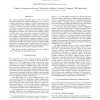Free Online Productivity Tools
i2Speak
i2Symbol
i2OCR
iTex2Img
iWeb2Print
iWeb2Shot
i2Type
iPdf2Split
iPdf2Merge
i2Bopomofo
i2Arabic
i2Style
i2Image
i2PDF
iLatex2Rtf
Sci2ools
ICASSP
2011
IEEE
2011
IEEE
Improved speaker recognition when using i-vectors from multiple speech sources
The concept of speaker recognition using i-vectors was recently introduced offering state-of-the-art performance. An i-vector is a compact representation of a speaker’s utterance after projection into a low-dimensional, total variability subspace trained using factor analysis. A secondary process involving linear discriminant analysis (LDA) is then used to improve the discrimination of i-vectors from different speakers. The newness of this technology invokes the question as to the best way to train the total variability subspace and LDA matrix when using speech collected from distinctly different sources. This paper presents a comparative study of a number of subspace training techniques and a novel source-normalisedand-weighted LDA algorithm for the purpose of improving i-vectorbased speaker recognition under mis-matched evaluation conditions. Results from the NIST 2010 speaker recognition evaluation (SRE) suggest that accounting for source conditions in the LDA matrix as opposed t...
ICASSP 2011 | Mis-matched Evaluation Conditions | Signal Processing | Speaker Recognition | Total Variability Subspace |
| Added | 21 Aug 2011 |
| Updated | 21 Aug 2011 |
| Type | Journal |
| Year | 2011 |
| Where | ICASSP |
| Authors | Mitchell McLaren, David A. van Leeuwen |
Comments (0)

